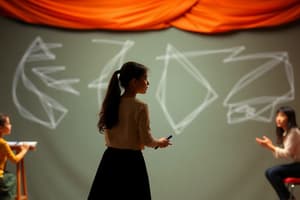Podcast
Questions and Answers
What is a still-image?
What is a still-image?
A frozen moment created by posing still bodies, used to crystallise a moment, idea, or theme.
What does pace refer to in performing?
What does pace refer to in performing?
The speed the dialogue is delivered to the audience.
What is thought-tracking in drama?
What is thought-tracking in drama?
Being stopped during in-role activity to reveal a character’s inner thoughts.
What do you do in role-play?
What do you do in role-play?
What is the purpose of narration in drama?
What is the purpose of narration in drama?
What is hot-seating in drama?
What is hot-seating in drama?
What does slow-motion achieve in performance?
What does slow-motion achieve in performance?
What is mime?
What is mime?
How does physicality affect character portrayal?
How does physicality affect character portrayal?
What is multi-rolling in drama?
What is multi-rolling in drama?
What is the significance of facial expression in drama?
What is the significance of facial expression in drama?
What does posture indicate in acting?
What does posture indicate in acting?
Study Notes
Creating Theatre Techniques
- Still-Image: A static pose resembling a photograph, capturing a moment, theme, or idea through facial expressions, gestures, and spatial awareness.
- Thought-Tracking: A technique where actors reveal a character’s internal thoughts during a performance, enhancing the depth of the role.
- Role-Play: Involves embodying another character, imagining their thoughts and feelings to create a believable performance.
- Hot-Seating: An interactive method where an actor answers questions in character, deepening their understanding and connection to the role.
- Slow-Motion: The deliberate control of body movement and expression to extend a moment, altering the audience's perception of time.
- Mime: Storytelling through gestures and facial expressions without spoken dialogue, conveying meaning solely through physicality.
- Multi-Roling: The portrayal of multiple characters by a single actor, marked by distinct changes in voice, movement, and body language.
Performing Theatre Techniques
- Pace: Refers to the speed at which dialogue is delivered, influencing the tone and tension of the performance.
- Voice: Involves manipulating pitch, volume, and tone to convey character emotion and clarity.
- Projection: Ensures dialogue is audible by using vocal power, crucial for engaging the audience.
- Emphasis: Involves stressing specific words to highlight their significance and emotional weight in a delivery.
- Volume: The control of loudness or softness of voice, key to maintaining audience interest and engagement.
- Movement: The physical way an actor moves can express a character’s age, state of being, or emotional condition.
- Physicality: Encompasses an actor’s body language, including posture and gestures, contributing to the portrayal of character emotions.
- Gesture: Often highlights emotions through physical movements, such as clenching fists to show anger.
- Mask: Using masks in performances to enhance focus on body language and gestures, emphasizing emotional delivery.
- Facial Expression: The use of facial movements to indicate a character’s feelings, such as frowning to suggest sadness.
Additional Concepts
- Physical Theatre: A performance style that emphasizes movement and physical expression as primary storytelling devices.
Studying That Suits You
Use AI to generate personalized quizzes and flashcards to suit your learning preferences.
Related Documents
Description
This quiz focuses on key terms and definitions related to drama for Year 7 students. It covers concepts such as still-image, pace, and voice, which are crucial for creating and performing in drama. Test your understanding of these fundamental ideas.




